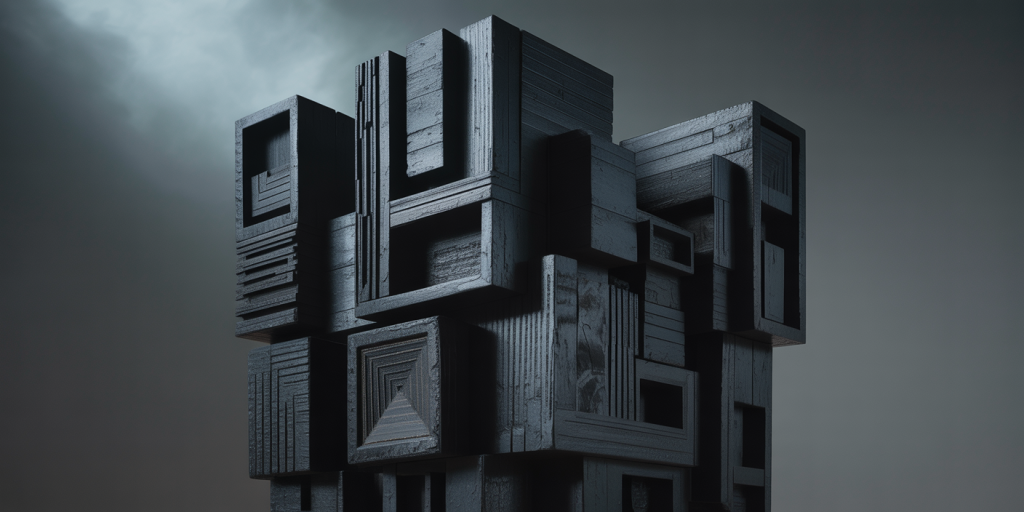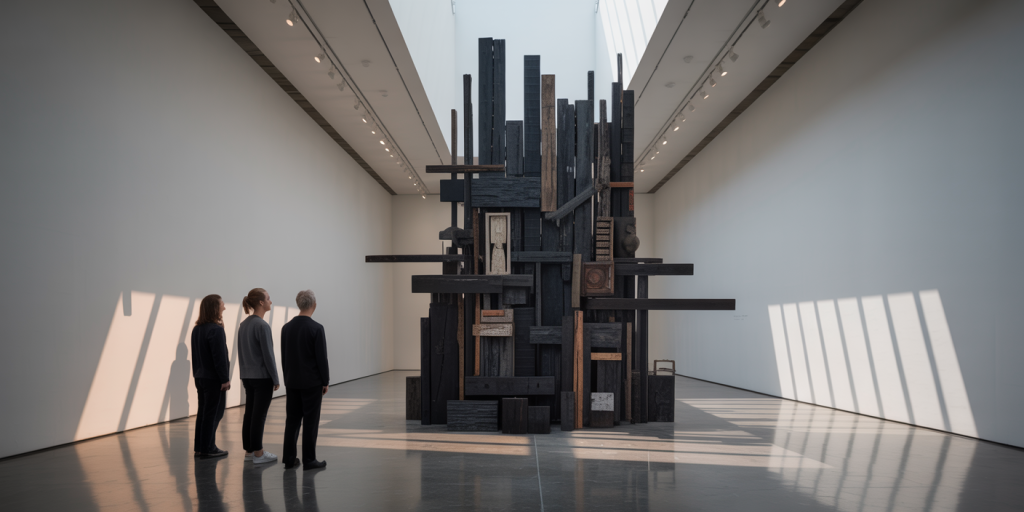Louise Nevelson’s Touch in Fragments of the Feminine Shadow
There is a hush in the realm of sculpture where shadows breathe and silence speaks. Louise Nevelson’s creations do not demand attention through grandeur or spectacle—they emerge like secrets unveiled in moonlight, fragments stitched from memory, myth, and matter. Her world is assembled from forgotten wood, relics of urban decay, and the detritus of modern life, resurrected with reverence into towering altarpieces. Through these structures, she evokes the silent voice of the feminine shadow—mystical, intuitive, and long obscured.
In Nevelson’s assemblages, we wander through psychic corridors where the feminine is not an object of display, but a force of gathering, concealment, and inner vision. Her works speak in whispers, carry the aroma of dust and dreams, and lead the viewer inward. They are less about what is shown and more about what is felt in the negative space.
Table of Contents
- The Sculpted Murmur of Memory
- A Cloister of Wooden Echoes
- Dust and Divinity in Black
- Geometry of the Inner Labyrinth
- The Cathedral of Found Things
- Rituals in Negative Space
- The Feminine and the Fragmented
- Assemblage as Alchemy
- The Weight of Emptiness
- Thresholds of Intuition
- Daughters of Silence
- The Shadow Carved in Wood
- Archetypes in Charcoal and Shadow
- A Language of Hidden Altars
- Gestures of Accumulation
- Darkness as Sanctuary
- Time Suspended in Grain and-Glue
- The Sorceress and the Structure
- Unfinished Voices in Sculpted Silence
- Echoes that Refuse to Fade
The Sculpted Murmur of Memory
Nevelson’s sculptures emerge not as monoliths but as collective memories, each fragment whispering its own past. Memory is tactile here—the textures of worn wood, rusted nails, and peeling paint invoke a life lived, abandoned, and reawakened. The feminine, too, is presented as a murmuration of remembered roles and dismembered icons, gathered anew in sacred assembly.
A Cloister of Wooden Echoes
Each box within her larger structures acts like a cloistered cell, where fragments live in quiet dialogue. These wooden compartments echo the architecture of both confinement and contemplation—spaces where the feminine self, historically secluded, finds presence. The echo is not empty but resonant, filled with what once was and might again be.
Dust and Divinity in Black
Nevelson famously chose black as a primary hue—not for its void, but for its vastness. Black holds all colors, just as the feminine shadow holds multitudes. In works like “Sky Cathedral,” black becomes divine: a sacred absorption of light, history, and breath. Dust settles as benediction upon her surfaces, sanctifying the discarded.

Geometry of the Inner Labyrinth
Her compositions mimic the mind’s architecture. Every panel, slot, and silhouette draws the viewer into an inner maze, a feminine labyrinth where logic yields to sensation. There’s order, but not of reason—it’s the intuitive geometry of dreams, sorrow, and cycles.
The Cathedral of Found Things
Nevelson creates sanctuaries from the castoff. She gathers street remnants with the eye of a mystic, and transforms the mundane into monuments. Each sculpture becomes a reliquary of forgotten lives and unnoticed moments, a feminist liturgy written in wood.
Rituals in Negative Space
What is absent in Nevelson’s work is just as meaningful as what is present. The voids are not emptinesses but vessels—spaces prepared for presence. These negative spaces function like ritual vessels, waiting to be filled by the viewer’s gaze and spirit.
The Feminine and the Fragmented
Nevelson does not offer wholeness in the traditional sense. Her figures are not statuesque heroines but scattered, obscured, and partially revealed. This fragmentation mirrors the historical splintering of the feminine voice. Yet in this shattering, she constructs new mythologies.
Assemblage as Alchemy
The act of assemblage is deeply alchemical—the transformation of the base into the luminous. Nevelson’s art elevates refuse into reverence. She is a sorceress of the studio, conjuring presence through process, giving new souls to inert objects.
The Weight of Emptiness
Though voluminous, her works feel paradoxically light. The repetition of shapes, the rhythm of form, and the orchestration of shadow suspend the weight. Emptiness becomes palpable and carries the same intensity as matter. The feminine is no longer burdened, but freed through abstraction.
Thresholds of Intuition
Each sculpture functions as a threshold, inviting entry not through intellect but intuition. To behold a Nevelson is to stand before an oracle. The viewer becomes participant, deciphering symbols, receiving the unseen. The artist becomes medium.
Daughters of Silence
Her sculptures are daughters born from silence. Not silence as repression, but as gestation. These works incubate meaning. They do not shout; they summon. Their silence is agency, not absence. They inherit the hush of sacred groves and feminine rites.
The Shadow Carved in Wood
Nevelson sculpted not only matter, but shadow. Her works are chiaroscuros in three dimensions. The shadow becomes subject, not side-effect. It is the feminine unconscious, the psychic twin of every visible form. Carved, enclosed, and revered.
Archetypes in Charcoal and Shadow
Her works echo Jungian archetypes—the Great Mother, the Sorceress, the Priestess—without depicting them. Through repetition and concealment, she evokes the collective unconscious. Her black wood becomes like charcoal sketches of dreams half-remembered.
A Language of Hidden Altars
Each box, niche, and shelf becomes an altar. But these are hidden shrines, not for public worship. They belong to the intimate feminine domain—devotional, private, enigmatic. The viewer peers into these boxes as if entering sacred space.

Gestures of Accumulation
Her method is not one of chiseling away but gathering. Accumulation becomes an artistic gesture of nurture. In assembling, Nevelson reflects the traditionally feminine act of holding together—households, memories, generations. She is a sculptor-mother.
Darkness as Sanctuary
The darkness in Nevelson is never danger—it is refuge. A womb of forms. A sanctuary where meaning gestates away from the gaze of harsh light. Her sculptures are protective spells cast in shadow.
Time Suspended in Grain and Glue
Each sliver of wood carries the grain of time. The patinas, stains, and cuts record previous lives. Nevelson does not erase these stories but unites them. Through glue and arrangement, she suspends time—a sacred montage of the eternal now.
The Sorceress and the Structure
Nevelson is not merely an artist but a conjurer. She builds spells out of structures, glyphs out of garbage. Her assemblages are not inert; they vibrate. In them, one feels the presence of a guiding hand, both maternal and mystical.
Unfinished Voices in Sculpted Silence
Each sculpture feels mid-sentence, like a myth paused. There is deliberate incompletion—an openness that invites the viewer’s voice. The feminine shadow here is not a final answer, but an eternal becoming.

Echoes that Refuse to Fade
Even as decades pass, Nevelson’s works hum with resonance. Their echoes do not fade. They refuse to be silenced. They continue to speak to the feminine psyche, to those seeking form in fragmentation, light in blackness, voice in shadow.
FAQ
Who was Louise Nevelson?
Louise Nevelson (1899–1988) was an American sculptor known for her monumental, monochromatic wooden assemblages. Born in Ukraine, she immigrated to the U.S. as a child and became a key figure in 20th-century modernist sculpture.
What is Nevelson’s signature style?
Nevelson is known for large wall-like sculptures composed of wood fragments painted uniformly—often black, white, or gold. Her works emphasize negative space, texture, and abstract composition.
What does the use of black signify in her work?
For Nevelson, black was the totality of all color. It signified depth, mystery, and spiritual richness. She viewed black not as absence, but as presence.
Why is Nevelson considered a feminist artist?
While Nevelson resisted labels, her reclamation of castoff materials and assertion of presence in a male-dominated art world marked her work as deeply feminist. Her art elevates the hidden, the fragmented, and the intuitive—qualities historically linked to the feminine.
What is assemblage art?
Assemblage is an art form that involves creating sculptures by compiling found objects. Nevelson was a pioneer in this medium, using discarded wood to form coherent and evocative structures.
Notes from the Darkened Shrine
In the stillness of Nevelson’s chambers, the feminine shadow gathers form. Through grain and gap, black and breath, her works speak with a language of silence. They remind us that the sacred is not only found in the luminous but also in the neglected, the veiled, the fragmentary.
Louise Nevelson touched each piece with ritual. Her hands assembled not only wood but lineage. Each sculpture stands as an altar to the unseen and the unheard—a feminine force not erased but transfigured. Her voice remains, not in declarations, but in echoes that refuse to fade.
